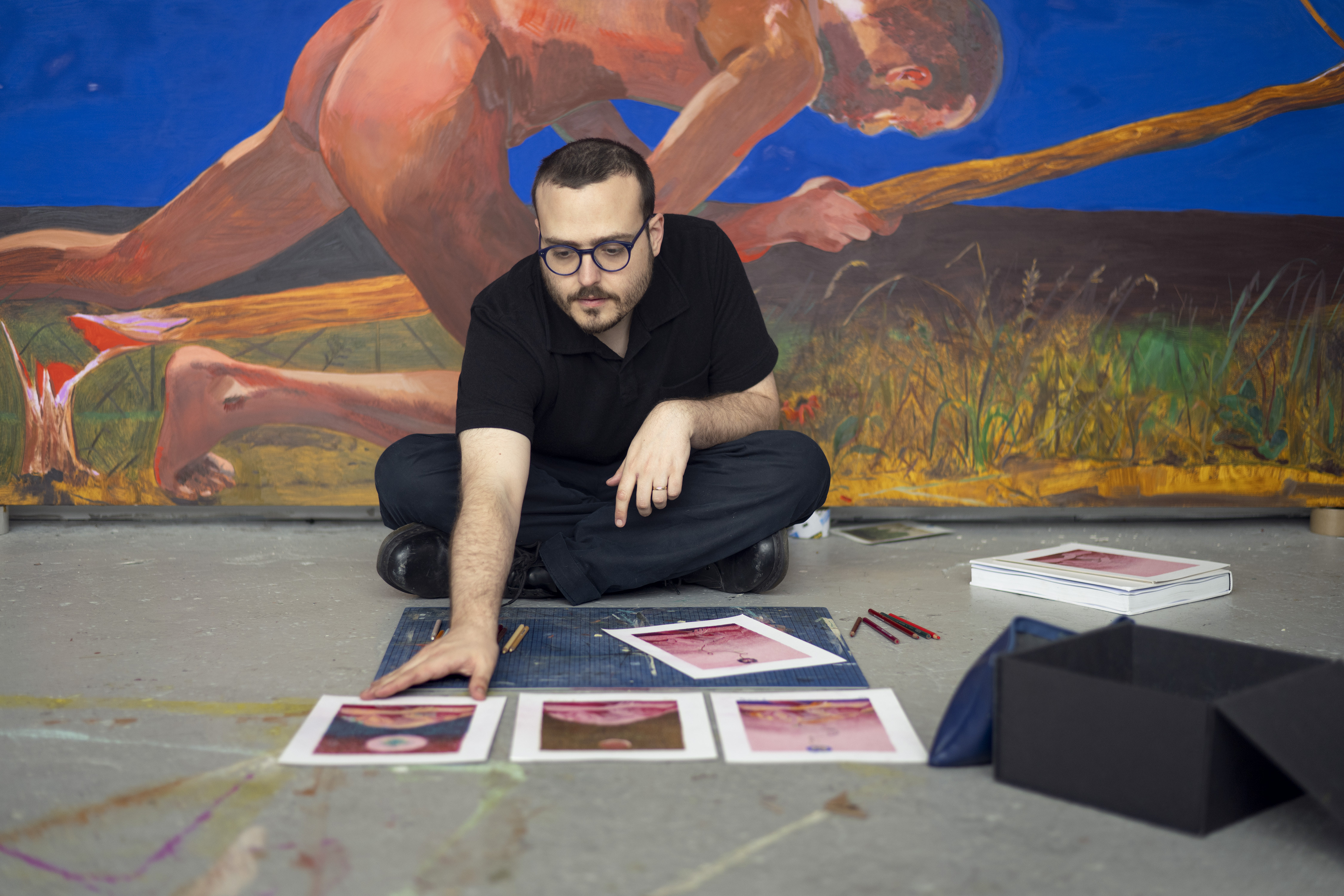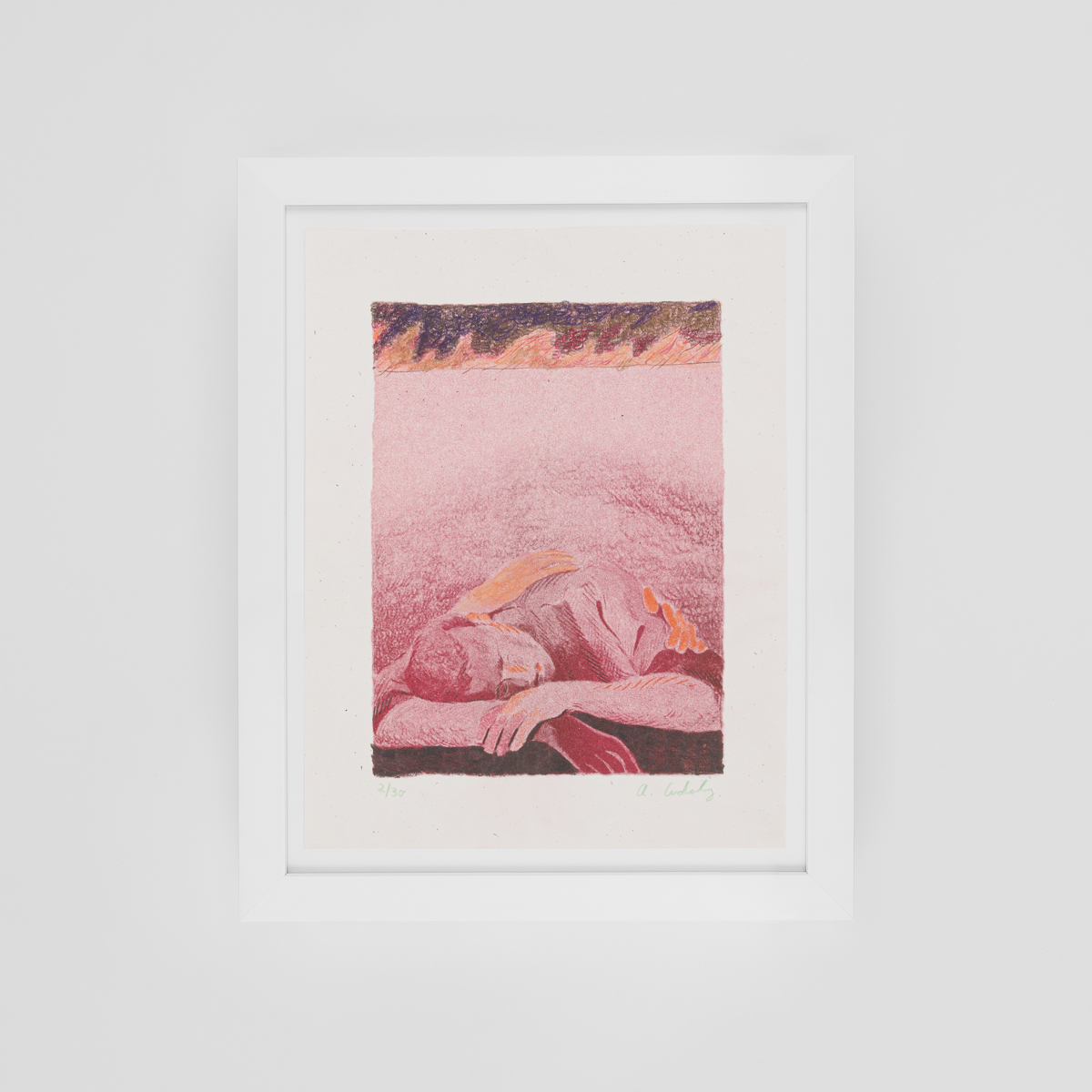The people who populate Anthony Cudahy’s drawings and paintings are almost apparition-like. But despite the private universe they seemingly inhabit, we feel close to them – to the point where we feel we could reach out and place a protective hand upon them.
At heart, Cudahy’s paintings, drawings, and prints are incredibly personal expressions of human connection. Yet the quiet in the scenes Cudahy depicts can suggest a collective isolation too.
And it’s these opposing emotions the increasingly acclaimed Florida-born, Brooklyn-based artist returns to again and again. Cudahy, who traditionally sources his imagery from family photos, pictures from gay and lesbian archives, print ephemera, and from the high points of art history going back to the Middle Ages, says he sometimes lands on an image that is flexible and interesting enough for him to want to do many iterations of it.
He had already made two paintings and one drawing of the image that has generated his new Artspace & Monacelli edition, Sleeper with Signs, 2024, which sprung from a film still of the art critic, curator, and AIDS activist Douglas Crimp in repose.
Consistent with the recurring approach of his wider practice, Cudahy has made a series of embellishments to each of the 30 editions, every one of them unique.
“For this edition, I wanted to create a series of dreams above the sleeper, each different, with the figure as an anchor,” Cudahy tells us. I love multiples and iterations, especially if there is a subtle uniqueness to each.”
This week, these unique variants are released in an edition of 30 plus 3 artist proofs. Each unique edition is accompanied by the artist’s first comprehensive monograph, Anthony Cudahy: Spinneret, published by Monacelli Press. The package is $2,000 with a framed print, $1750 unframed, with proceeds from the edition going to the Ogunquit Museum and Doctors Without Borders.
 Anthony Cudahy working on the editions in his studio – photo by Nir Arieli
Anthony Cudahy working on the editions in his studio – photo by Nir Arieli
Cudahy is represented by Grimm and Hales galleries; and his work is held in the permanent collections of the Baltimore Museum of Art, MD; Cantor Arts Center at Stanford University, CA; Dallas Museum of Art, TX; The Hort Family Collection, New York, NY; Institute of Contemporary Art, Miami, FL; Kunstmuseum, The Hague and Stedelijk Museum, Amsterdam, NL, among other global arts institutions.
On the eve of the release of Sleeper with Signs, 2024, , we asked Cudahy about the edition, his work, and a remarkable career trajectory that’s seeing him fast become one of the most important artists of 2024.
The original artwork from which the edition springs is called Sleeper with Thorns. The edition is called Sleeper with Signs. What’s the thinking behind the revised title?Sometimes I land on a persistent image that is flexible and interesting enough for me to want to do a few iterations of it. I made two paintings and one drawing with this sleeper figure who is being held (or protected) with a scene above. In one a fire burns in the distance, in another a comet flies across the sky, and in the drawing the print comes from, a thorny branch hung above the figure. For this edition, I wanted to play with this further, and create a series of dreams above the sleeper. Each different with the figure as an anchor.
What were the thoughts in your head when you made the original painting? Like most of my paintings, the image started in another image. I collect a lot of images constantly. I had saved a still from a film of Douglas Crimp asleep, laying on Gregg Bordowitz’s lap during what appeared to be an ACT UP meeting. It’s a really tender image with Bordowitz’s hand holding Crimp’s shoulder. The sleeping figure and “protective” figure pairing is what sparked an idea for the painting which I restaged.
You are making embellishments to the editions. What are they and how do they make each edition unique? Each will be a different scene, or a different dream above the sleeper. I am drawing in colored pencils on top of the riso prints.
ANTHONY CUDAHY – Sleeper with Signs, 2024 
Photo by Garrett Carrol
The colour relationships in your paintings are incredibly complex and not isolated to areas of one colour. Can you tell us a little about how you manipulate these elements to evoke a mood? Color and texture both create or alter narrative and are themselves experienced as sensations. Color especially (but texture in terms of the surface) is all relational and I try to make more and more complex paintings as I continue to work.
The positioning of your figures is very intimate, bringing a warmth and vulnerability to the paintings – can you tell us a little about this and what might draw you to these scenes of introspection? There’s usually a precarity involved in the set-up of my scenes. Similarly to the edition’s image, the figures are often fulfilling protective roles for each other, or if they are alone, they are frequently waiting or longing.
 Anthony Cudahy signing the editions – photo by Nir Arieli
Anthony Cudahy signing the editions – photo by Nir Arieli
We almost feel voyeuristic as viewers sometimes. How do you select the subjects of your paintings? At one point, earlier on in my painting, the figures were all from found and collected photographs, but were unknown to me. Sometimes I would similarly “find” a photo I had taken of my husband, Ian, and get an idea for a painting. He kind of acted as a bridge as my work developed and became more specific and narrative. Now it’s primarily people in my life that I “cast” in the paintings.
ANTHONY CUDAHY – Sleeper with Signs, 2024 
Photo by Garrett Carrol
How do you navigate the balance between narrative and interpretation in your works?I’m always trying to walk a tightrope. I like the paintings to have conflicting ideas and methods. Sometimes I think about narrative as a set of details or information that could be pulled apart and reassembled.
We love the fact that you have referenced Bruegel alongside Butt magazine. Where did your love of medieval imagery come from? I’ve always been drawn to the peculiarities of work from the early European Middle Ages through the Northern Renaissance. The different ways of cohering a space perspectively or relaying narrative information. But ultimately it’s the strangeness and unknowability. Most of our conceptions of that time period were a historical revision and fiction promoted during the Enlightenment. The period was a lot weirder and more fluid than it’s known to be. Maria Loh, who amazingly wrote an essay for the catalog, taught maybe the best class I’ve ever taken when I was in my grad program. Love and Death in Italian Art during the Middle Ages. It was life changing.

Anthony Cudahy in his studio, 2024 – photo by Nir Arieli
You have made reference to albums by Kate Bush, Panda Bear, and Arthur Russell as inspirations in your work, what is it that links these musical artists for you? Really deeply considering other mediums than what you work in gives you the chance to gain perspective on your own limits and potentials. I love the album format as a vehicle for collecting a body of work, and think of the planning of an exhibition, and how the work all sits with each other in a room, as related.
The complexity of all the moving parts inspires me, as does a lack of fear around emotion or performing. The Ogunquit Museum asked if I would make a playlist for my show, and I was incredibly happy to as it’s such a huge part of my life and influences the work.
ANTHONY CUDAHY – Sleeper with Signs, 2024 
Photo by Garrett Carrol
What is your approach in the studio? Do you plan meticulously or are you more spontaneous? The quality of the paint colors you get would suggest both approaches. There may be a color scheme idea or another painting (by another painter) that is in my mind when I start a painting, but once I get moving it’s all reaction and I try to let the painting happen without too much preconception. I’ll make a collage usually for the drawing of the piece, but this will also be deviated from as I paint.
 Photo by Garrett Carrol
Photo by Garrett Carrol
Do you buy editions yourself? If so, could you tell us the appeal they hold for you? We recently bought two Karlheinz Weinberger prints from a show of his work at SITUATIONS. Our dear friend Lily Wong gave us a lithograph she made at Idem in Paris. I was very involved in the NYC zine world at one point which is a part of why I was interested in this project incorporating risography. I love multiples and iterations, especially if there is a subtle uniqueness to each. Take a closer look at Sleeper with Signs, 2024 here.

